It’s easy to write about – and decide whether to buy – a vehicle that’s in a class by itself. That hasn’t got half a dozen or even any direct competitors.
That model being a brand-new one, from Hyundai . . .
The 2022 Santa Cruz
What It Is
The Santa Cruz is neither car, nor crossover, nor SUV. It has design elements of all of them – plus one more.
That being the truck-like 4.5-foot-long bed out back.
But the Santa Cruz differs from the typical truck in that it’s based on a car; well, a crossover (the Hyundai Tuscson) that’s based on a car (the Hyundai Elantra sedan). And unlike a truck, it’s not based on a rear-drive layout with 4WD (and low range gearing) available but front-wheel-drive, with AWD available.
It’s just the thing for people who don’t need (or want) something that looks like a truck – or which is as big and unwieldy as a truck can be – but really like the idea of having a bed for carrying stuff that won’t fit in a crossover.
A bed that you can easily load and unload without needing a step ladder. One that comes attached to a smaller, car-sized vehicle that’s just as good for snow-day driving as any crossover . . . without being just another crossover.
Prices start at $24,140 for the base SE trim with front-wheel-drive; adding the available AWD system bumps the price up to $25,460. After that come SEL, SEL Premium and top-of-the-line Limited trims, the latter two coming standard with AWD and a more powerful (turbocharged) version of the 2.5 liter engine that’s standard in the SE and SEL trims.
A top-of-the-line Limited packs the kitchen sink with features, including leather seats, a larger 10.25 inch LCD touchscreen, digital dashboard, adaptive cruise control and a Bose premium audio system. This one stickers for $39,870.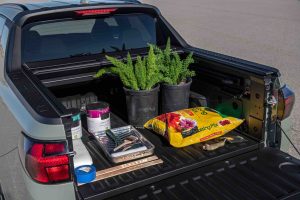
All trims have four full size doors and – of course – the 4.5 foot bed out back.
The next-closest thing on the market is the also-new Ford Maverick, which is meant to look like a small truck – though it’s also based on a compact crossover (the Escape).
It’s less expensive – $19,995 to start – and offers more towing capacity as well as a standard hybrid drivetrain, which the Hyundai doesn’t offer yet but may, in time.
Both of these rigs fill the gap left by the complete absence – in the United States – of a compact-sized truck. These having been supplanted by “mid-size” trucks such as the Nissan Frontier Ford Ranger and Chevy Colorado/Canyon that are very close to being as big as full-size pick-ups used to be.
Current full-size trucks being super-sized trucks.
What’s New
The Santa Cruz is an all-new model. 
What’s Good
The truck for the person who doesn’t want one.
The car for the person who sometimes needs a truck.
The crossover for the person who doesn’t want to own just another crossover.
Uses almost as much gas as a truck (22-23 MPG, average).
Optional turbo engine is only available in much more expensive SEL Premium and Limited trims.
The Ford Maverick gets much better gas mileage and you can buy one with a similarly powerful (optional) engine for much less money.
Under The Hood
SE and SEL trims come standard with a 2.5 liter four cylinder engine that produces 191 horsepower – paired with an eight speed automatic transmission and either front-wheel-drive or (optionally) all-wheel-drive.
One of the upsides of this Hyundai’s 2.5 liter engine is that it’s a fairly large engine, as four cylinders go – and for that reason doesn’t need a turbo to make almost 200 horsepower. Some will remember when that was good number for a V8 engine.
The absence of a turbo means you’ll never have to worry about replacing one – or any of the peripheral parts that usually come with turbocharged engines, such as an intercooler and special exhaust plumbing. Also, a non-turbocharged engine is under less pressure – literally – and that ought to mean greater longevity. 
On the downside, this engine is thirsty for what it is – averaging just 23 MPG (21 city, 26 highway). For reference, a full-size Chevy Silverado 1500 pickup with a 5.3 liter V8 engine averages 19 MPG (17 city, 23 highway).
But the Santa Cruz isn’t so much about saving gas as it is about saving size. A full-size pick up like the Silverado is . . . full size.
The Santa Cruz is about half that size – and has almost as much bed as some latter-day full-size trucks (more on that below). It also costs much less than a Silverado – which stickers for just shy of $30k to start.
Which is way to save on gas by not spending on the vehicle.
SEL Premium and Limited trims also come standard with a 2.5 liter engine – but this time, it is turbocharged. On account of that, it produces 281 horsepower and 311 ft.-lbs. of torque (not-too-far-off the torque produced by small V8s). 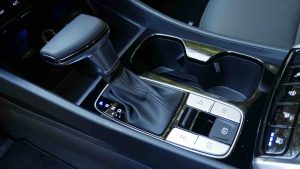
This version of the 2.5 engine is also paired with an eight speed automatic and this time, AWD is standard equipment.
Interestingly, this much more powerful engine doesn’t use much more gas than the standard 2.5 liter engine – even with standard AWD. It averages 22 MPG (19 city, 27 highway) so there’s no fuel efficiency cost associated with opting for the stronger engine.
However, there is another cost.
This engine is only available in the SEL Premium and Limited trims, which means you’d have to spend at least $35,830 to get it – which is a startling $11,690 more than Hyundai asks for the base SE trim with the not-turbocharged version of the 2.5 liter engine, which (again) stickers for a much more accessible $24,140. You may not be spending more on gas, but you’ll be spending a lot on horsepower. 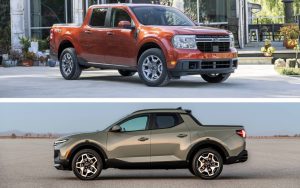
Which brings up the Ford Maverick – the Santa Cruz’s most serious, if indirect, rival. This one stickers for just $19,995 to start – which is about $4k less than the base price of the Santa Cruz – and it comes standard with a very fuel-efficient hybrid drivetrain that averages 37 MPG (42 city, 33 highway).
That saves you money on gas – and the vehicle.
You can also get the Ford with its optionally available 2.0 liter turbocharged engine in the base $19k trim, as a $1,085 option. With AWD added, the cost for the upgrade rises to $3,305. Even so, the price of the Ford with the stronger (250 hp) 2.0 engine and AWD is still only $23,300 – about a thousand bucks less than the base SE Santa Cruz with FWD and just 191 hp.
But the Maverick’s still a truck – at least, in terms of its looks. Even though it isn’t, actually.
Like the Hyundai, the Ford is based on a layout that’s similar to that of FWD/AWD cars that have been turned into crossovers. Neither are heavy-duty rigs but the Ford does offer a higher 4,000 pound maximum tow rating than the Hyundai, which pulls up to 3,500 pounds – but only when equipped with its optional and much-more-pricey turbocharged engine.
It’s nice to own a truck that doesn’t drive like one.
This isn’t a reference to ride quality; modern trucks ride better than Cadillacs used to – and also handle a lot better. They are far from being the crude (in comparison to cars) rigs they once were.
But they’re huge.
Even the “compact” models like the current Nissan Frontier, Ford Ranger and Chevy Colorado/GM Canyon – all of which are dimensionally very close to being the same size as full-size trucks were as recently as the 1990s.
It’s not just that they’re long, either. They are also very high – which some people like, once you climb up into their cabs because you can see over all of the cars on the road. But you do have to climb into them.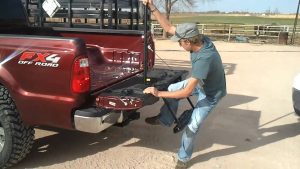
And not everyone likes having to do that.
The Santa Cruz doesn’t require rock-climbing gear to get in. It’s about the same height as most crossovers, which means you just get in. Once in, you feel as you would behind the wheel of a crossover – without having to drive another crossover. And when it comes time to stop driving – and park – it’s as easy to do as would be the case if you were driving a same-sized crossover (or car). It also leaves space in your driveway or garage to park other things, too.
With the standard engine, there’s pick-up enough to get to 60 in about 7 seconds, which is significantly – as in noticeably – quicker than the hybrid Maverick. With its optional turbocharged engine, the Santa Cruz is very quick, getting to 60 in six seconds flat. Either way, there’s plenty of power for merging and passing without straining.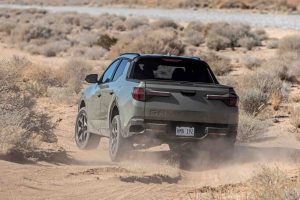
It’s also got clearance enough – and grip enough – to play off road, if you like. Just don’t go too far (or deep) because like other FWD/AWD crossovers the SC doesn’t have a two speed transfer case and low range gearing.
But you can “lock” the AWD system’s front-rear power split for maximum traction in snow, dirt and mud.
The chief deficit here is its thirst – with either engine. The optional turbo engine has the compensatory virtue of being very strong but the base engine lacks that, which detracts from the otherwise high appeal of this very practical – and very fun – little kinda-sorta truck that isn’t really.
Even with a full tank – and this little “truck” has a fairly large almost 18 gallon capacity tank – its range in city driving is only 371 miles. For perspective, the hybrid Maverick has a city range of 579 miles on just shy of 14 gallons. With a gallon of gas currently averaging more than $4 as of mid-March (Let’s Go Brandon!) that’s a very noticeable difference – and not just in terms of distance.
Hyundai could have closed the distance by offering this little big rig with a diesel engine and – wishes used to come true – a manual transmission. When VW was able to offer that combo in a roughly similar (in terms of size/weight) vehicle like its TDI-powered Golf Sportwagen (RIP) the result was 50 MPG and a 600-plus miles range.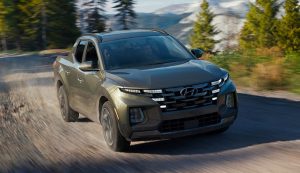
It’s tragic that neither VW – nor Hyundai – nor anyone else – can offer such fuel-efficient and cost-effective drivetrains in new vehicles on account of “emissions” regulations that are no longer based on reasonable considerations about air quality but rather on political considerations, such as the push to force electric cars down everyone’s throats.
Diesel-powered runabouts that average 50 MPG and go 600-plus miles that cost low-mid $20ks make 200 mile range EVs that cost $40,000 look ridiculous.
Which, of course, they are.
And that’s why we’re not allowed to buy diesels, anymore.
At The Curb
Two thirds of the Santa Cruz is crossover.
It’s the 4.5 foot bed that comprises the other third that makes this anything but another crossover. The bed is in some ways more useful than a truck’s bed – even though it is shorter than a truck’s bed – in part because it is more usefully wider. Which it is because it hasn’t got the usual pair of huge wheel humps protruding into the bed that you find in most truck beds, that restrict what you can slide into them.
The reason for that being the Santa Cruz isn’t a truck – and so doesn’t have a massive (usually, cast iron) rear axle, as most trucks have out back. Room has to be made for that and the bed is where that happens.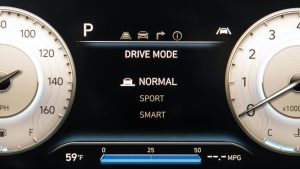
But not here – because room doesn’t have to be carved out for what’s not there.
There is also room under the bed – for another bed. This one is an insulated tub, with a drain, that is just the ticket for hauling several bags of ice and your favorite beverage or putting fish and such on ice. I’s also a good place to hide things you’d prefer others not see.
Hyundai also offers a rollback plastic cover that keeps whatever’s in the bed out of the weather. It’s much handier than a fabric tonneau cover that you have to secure in place before you can drive off.
But perhaps the most appealing thing about this Hyundai’s bed is that you can get to whatever’s in it without needing a step ladder, as almost all current trucks come standard with, because their beds (and bed walls) are so high that even a man well over six feet tall cannot touch the floor of the bed without standing on a milk crate.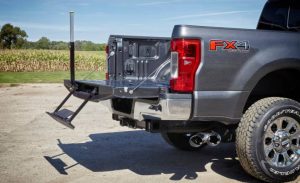
Using the Hyundai’s bed is much easier, which makes it much more useful.
It is also proportionate – to the rest of the vehicle. There is visual as well as functional absurdity to be seen when one sees a half-ton truck that’s twice as long as this Hyundai but which has a bed that’s barely longer and which doesn’t hold much more, either.
The Rest
Hyundai equips the base SE and next-up SEL trims abundantly; highlights include a very good six speaker stereo and 8-inch touchscreen (SE) as well as heated seats and outside mirrors, plus the lockable/hidden storage bin under the bed out back (SEL).
On the downside, many desirable features – such as the even-better Bose premium audio system, navigation and rear seat USB charge ports – are restricted to the much more expensive SEL Premium and Limited trims.
Along with the stronger turbocharged version of the 2.5 liter engine.
This is deliberate – meant to “upsell” buyers who want those features into an SEL Premium or a Limited. But it might cost Hyundai some sales – to Ford – which will sell a Maverick for a lot less and let you buy many desirable options without buying the more expensive trim to get them.
The Bottom Line
It’s nice that small trucks are making a comeback – even if they aren’t, really.
. . .
Got a question about cars, bikes or anything else? Click on the “ask Eric” link and send ’em in! Or email me at EPeters952@yahoo.com if the @!** “ask Eric” button doesn’t work!
If you like what you’ve found here please consider supporting EPautos.
We depend on you to keep the wheels turning!
Our donate button is here.
If you prefer not to use PayPal, our mailing address is:
EPautos
721 Hummingbird Lane SE
Copper Hill, VA 24079
PS: Get an EPautos magnet or sticker or coaster in return for a $20 or more one-time donation or a $10 or more monthly recurring donation. (Please be sure to tell us you want a magnet or sticker or coaster – and also, provide an address, so we know where to mail the thing!)
My eBook about car buying (new and used) is also available for your favorite price – free! Click here. If that fails, email me at EPeters952@yahoo.com and I will send you a copy directly!




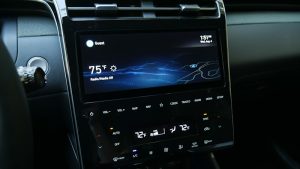









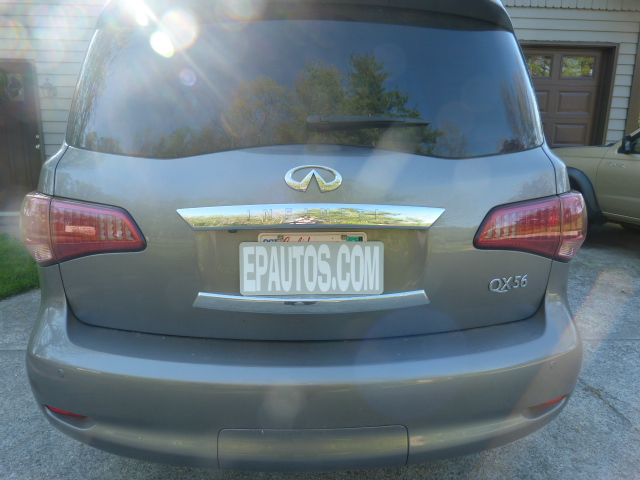
Wonder why no one makes small (real) trucks any more. There must not be much of a market for them any more, as the
USGOV hasn’t yet mandated trucks to be a certain minimum size.
We do see the same problem in other vehicle categories. The latest Civic is bigger than the 1990s Accord for one.
Hi Escher,
Two reasons, chiefly: The main being that there is less profit in small trucks and by cancelling them, the manufacturers have been able to upsell people into what are styled “midsized” trucks that are almost as big as full-size trucks once were. Small trucks are also often made outside the U.S. and importing them triggers the imposition of the “chicken tax,” which renders them more expensive and less profitable.
Finally, Americans – not all, but many – have embraced the Debt Life and living beyond their means. Rather than buy a small truck that would suit their needs for $18k they finance a $50,000 truck instead.
FYI – the max towing for the Santa Cruz is 5000 lbs with the bigger engine and AWD. That means it beats the Maverick for towing – base engine 3500 vs 2000. Turbo engine and AWD 5000 vs 4000.
I saw 3 or 4 of them on the road the other day. They looked better than I thought they would based on pictures, but I prefer the Maverick style wise. I haven’t seen any Mavericks yet.
Makes ya wonder how much it’d cost for someone to create a niche company to create what people really want but low enough #’s to avoid the govt regulations.
Doesn’t even need to be their own stuff, source a vw 2.0tdi (2000s or 2010 engines), rebuild them, get a rwd or 4×4 shell of some midsized truck for reference and build one for the modern world without modern features (i.e. 6spds with 6th for cruising, big enough brakes, led headlights and tail lights at most, but otherwise no ASS, or other annoying features no one wants)
As I said on Gab, we need to find a way to get rid of CAFE and other useless stuff, as we the people never asked for the EV future. Has to be people running who will stand for us instead of making us feel like whiney outcasts
‘The Santa Cruz is neither car, nor crossover, nor SUV.’ — eric
First impression of the top photo is that the Santa Cruz reminds me of the Honda Ridgeline.
Strange that the Santa Cruz and the Ford Maverick are the only current vehicles that approximate the compact pickups offered in the 1980s and 1990s and early 2000s.
Saved the comment by Anonymous on VW Caddys with engine swaps.
I don’t really want to go back that far. But where else are you going to find a 2,100 lb bantamweight truck, grandfathered in like an old house that could never meet current building codes?
If any pickup should come along
Gonna give you any love and affection
I’d say get it while you can, yeah
Hey, hey, get it while you can
— Janis Joplin, Get It While You Can
Hi Jim,
Like you, I’d like to see someone make a small (real) pickup again. Something like my ’02 Frontier – or the old Ranger. I like this new SC and also the Maverick because they’re reasonably priced and functional. But I doubt they’ll last the 20-plus years needing only basic maintenance during that time my Frontier has lasted… with years yet to go.
If America were still an affluent society – rather than a debt-riddled society – then these expensive/more complicated/shorter-lived vehicles would make a perverse sort of sense. Or at least, it might be ok to indulge. But I think a degree of austerity is not only called for but might even be healthy at this point. A basic $12k vehicle one could either pay for at once – or pay off within 2-3 years.
This looks like a nice vehicle for weekends. I watched Sarah-N-Tuned’s review last night, she ran it through her standard off road test. Didn’t get up the hill climb but seemed OK with everything else. She mentioned the tires are strictly all-season road tires, so an upgrade to M/S treads would probably make the milage even worse.
Hi Eric
I have seen some Nissan D21 pickups with the VW 1.9 azz diesel swap also the VW alh diesel is swapped into lots of trucks and small off road vehicles.
https://www.thenewx.org/threads/xterra-tdi-swap.164506/#post-2577810
The 1980 VW Rabbit diesel pickup truck also called caddy was $6000 new ($20,000) in 2022 dollars. It could get over 50 mpg on the highway, 600 mile range. The mechanical injection diesel engine (no computer) would go 400,000 miles before a rebuild.
With a later azz VW diesel swap you could get more power or with a VW alh computerized diesel you get even more power plus economy, with an alh swap 0 to 60 in 6 sec. and over 50 mpg. These trucks also handled like a sports car.
With a 1.8 20vt VW engine swap with stage 2 tune = 240 hp they are very fast, 0 to 60 4.6 sec. they only weigh 2100 lb. Lots of these have engine swaps to make them a performance truck.
These VW caddy’s were the best all round truck/sports car/performance cars ever made, with a amall camper on the back you can live in it.
These trucks were so good they are a cult collector truck that are going up in value.
The Ford Maverick is 3600 lb. The Santa Cruz is 4100 lb. The VW caddy is 2100 lb. All the extra weight is because of government regulations.
Get a used VW caddy do the alh swap then 0 to 60 is the same as the Santa Cruz but with over 50 mpg fuel economy.
Get a used VW caddy do the 1.8 20vt VW engine swap with stage 2 tune = 240 hp, now 0 to 60 is 4.6 sec. a rocket, plus over 40 mpg highway and you can haul stuff.
A VW caddy with the engine swap is cheaper then a new Maverick or Santa Cruz.
Amen, Anon… I am viejo enough to remember those old diesel Rabbits. Slow, certainly. But they got you there, forever.
I missed a sale of one recently, I was too slow to respond, it was an azz diesel engined swap, the later azz was a mechanical injection engine but 1.9 litres, they will take lots of boost, turn up the boost, now it is quick, a very cool truck, now you have a sports car and a truck and great fuel economy, perfect for 2022 fuel prices.
Hi Eric,
The VW caddy pickup came with 1.6 lt. diesels either NA or turbo, with the turbo engine more power was available, with modification of the injection pump and increased boost a lot of power was available. There is a new hobby/business for you engine swap VW caddy pickup trucks, sell them at a profit.
An engine swapped 10 sec. 1/4 mile caddy.
https://car-from-uk.com/sale.php?id=116256
From what I’ve seen of the new mavericks they are even uglier then the rest of the atrociously styled modern vehicles. At least the Santa Cruz is visually appealing. I despise the new look of so called midsize trucks, the tailgates and rear end look 4 foot tall, with a lil bitty thin grille up front, combined with the rear stance of being way too high, all together making a grossly unappealing truck. I call it the ostrich look, head down in the dirt, ass up high in the air, looking dumb as hell
I concur, Rusty –
I love trucks – just not the new trucks. I’d far rather own a ’67 Ranger or maybe a late ’80s/early ’90s Chevy half-ton than any new truck. They’re ugly, as you say, as well as absurd. I’m taller than most men and it’s just ridiculous that a guy well over six feet needs a ladder to get into (or get at) the bed.
Exactly, my ’88 k1500 sits close to 2″ higher then stock due to overload springs and the torsion bars being turned up to compensate for the plow, and I can still reach nearly anything put into the bed, just reaching over the side. And its still a good looking truck, I get random people stopping by trying to buy it, and its parked back by the shop barely visable from the road. Gotta keep the ’93 inside, as it makes the 88 look like a junker lol. Every single time we take the 93 out for a drive someone tries to buy it, as its pretty rare to see a rust free 30 yr old std cab short box 4×4 chevy here in Michigan, and as it was ordered from the factory in the Corvette Quasar blue metallic paint, its an attention getter. I wouldn’t trade either for an entire dealerships worth of new trucks.
I respect your opinion. Here’s another perspective: I wouldn’t trade my late model Ram 1500 V8 long bed on any prior truck ever, even if the old trucks had money on the hood.
Yes it’s huge, doesn’t bother me in the least. It’s actually a bonus a lot of the time.
Would I rather have the 90’s size? Yes, IF it rode as well as the new one does, and is as quiet, and as fast, and tows as good, and has the nicest interior of almost any car I’ve ever owned (including caddys), etc…
Yes, the bed height is a nuisance, but again, I wouldn’t trade this one problem on the other 6-7 good things. It semi-solves it’s own height problem for me when loading bikes when the air bags lower to almost the old truck height. But I don’t lower it every entry-exit only cause the side steps make it pretty easy.
Another advantage of the size (and why I get the longer bed), is when we go dirt riding/racing, it’s usually 3hrs +/- away, so my friends all want to car pool (especially now). The older trucks would fit 2 bikes fine, but 3 was a geometry experiment. Not so now with the larger size, 3 bikes easy. And as a bonus the back seat is also now huge, our gear bags stay inside (3 of them) warm and dry, which we never could do in the older trucks.
Love em or leave em, and to each his own.
Amen, Chris –
Horse for course, eh?
What I’d like to see is a spectrum – ranging from compact trucks like mine to the super-sized trucks like yours. I think we’d have such a spectrum, too, if we had a free market. Instead, we get ever-dwindling choices largely defined by the government.
PS: I really like this idea – suggested by another reader here – to swap in a VW diesel for my gas-hungry four!
Agree 100%. so many fake problems created.
I liken my huge truck to the 70’s boat sedans I have always longed for. And the new big trucks do almost everything better except ‘float’, haha…
I forgot another big plus. The 4×4 systems are really good. Open end rear so you don’t swap the back end around in the rain, but backed up with a locker. Raise the truck up 2-3″ on the air-ride and I can go through 1 ft of snow with no concern. I wouldn’t have done that on my trucks prior. Use the max height and locker a lot too.
I don’t see this selling all that well. Those MPG’s are pathetic for such a small car. My ram pickup with the ecodiesel gets comparable numbers empty and can tow a 10,000 pound trailer without hurting itself.
The only reason would go so small is to get a break at the pump if I didn’t need an actual truck. (There I go again assuming what “I” would do is what everybody else would do.) Maybe a city dweller with limited parking options who needs a not-truck? I’m not seeing the point of this one with better less expensive choices available.
Hi Sicilian,
I can see it selling well – even against the Maverick, despite the latter being substantially less expensive and getting much better gas mileage. Here’s my reasoning:
The Hyundai isn’t pretending to be a truck while the Maverick is. The Hyundai isn’t a hybrid – and while it doesn’t get the great mileage the Ford hybrid gets, it is probably likely to last much longer, because it’s not a hybrid.
If I had to pick one or the other to replace my ’02 Frontier, I’d probably pick the Santa Cruz, for chiefly that reason.
“The Hyundai isn’t a hybrid – and while it doesn’t get the great mileage the Ford hybrid gets, it is probably likely to last much longer, because it’s not a hybrid.”
I ordered a base Maverick hybrid for $19k chiefly because I think it has the potential to be simpler and more trouble free than the turbocharged, 8-speed automatic alternative.
The Ford planetary eCVT is very simple. The hybrid technology they are using has been around for 15-20 years and the 2.5 MPFI Duratec is a proven, trouble-free gas engine. The hybrid drivetrain components, including battery are warrantied for 8 years/100,000 miles, and 10/150,000 in California.
Of course, as is true with any manufacturing, they have to execute the design properly and not use substandard components to ensure reliability. They also have to write the software without any bugs.
So I hope everything works out. With a first-year vehicle you never know… but in today’s economy if I can get a vehicle that can carry passengers like a car AND have a truck bed AND get almost 40 mpg for $19k… it’s a no-brainer.
Swing & a miss by Hyundai on this compared to the Maverick.
What is their market? Lesbian vegans?
@Dan (What is their market? Lesbian vegans?)
Subaru called, They want their crossover engineers back. You could seriously fit a lot of cat litter and gluten free veggie wraps in that bed.
I’m shocked that Hyundai is way more expensive and relatively less of a vehicle all around than the Ford Maverick. So did Ford just do an outstanding job or maybe Hyundai is betting on loyalty sales? Or?
The Santa Cruz is made (assembled) in Alabama
The Maverick is made (assembled) in Mexico.
Don’t forget the Honda Pilot was the originator in this segment, also made in Alabama.
I still long for the old days like the Chevy LUV. Wonder if they would still sell today? Of course they probably wouldn’t be allowed to be made due to current overreaching regs.
GM makes a competitor, and has for a while but only avail in South America, built in Brazil.